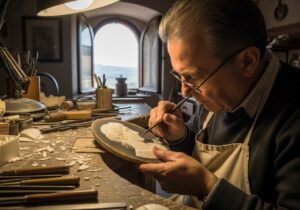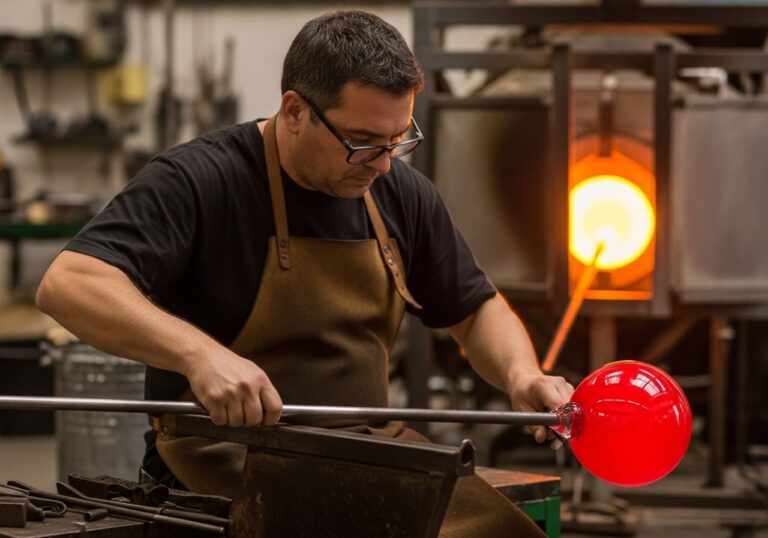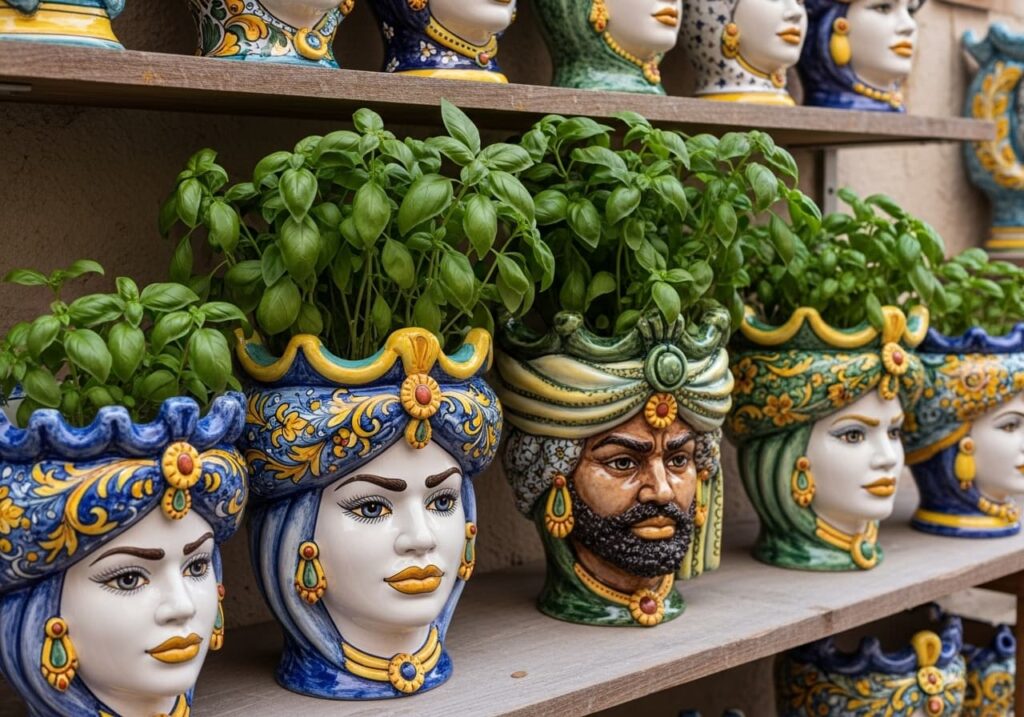Crafted Elegance
Discover Italian Artistry
Explore a curated selection of exquisite handcrafted products that embody the spirit of Italy.
Crafted with Care
Heritage and Craftsmanship: A Timeless Legacy
At the heart of our marketplace lies a celebration of Italian artisan families, whose craftsmanship weaves a rich narrative of tradition and innovation. These skilled hands have meticulously passed down their techniques, creating exquisite products that blend artistic heritage with modern elegance.
From fine textiles to gourmet delicacies, each item embodies a story of dedication and passion, connecting consumers directly to the producers in Italy.
Experience a curated selection of authentically made goods that not only reflect the creativity and skill of our artisans but also strengthen the bonds of cultural legacy. Every purchase supports sustainability and cultivates a deeper appreciation for the art of making. Join us in honoring these creators and discover the luxurious world of Italian craftsmanship.
Explore the Artisans Behind Our Treasures
Delve into the captivating stories of the artisans, whose passion and creativity breathe life into their exquisite collections. Interview that offer a personal glimpse into their craft and heritage, enriching your understanding of the authentic Italian products available. Get ready to connect with the people behind these Italian treasures.

The Eternal Cameo:
From Rome to Torre del Greco
Imagine holding in your palm a portrait that could have adorned the breast of an emperor. A face that rises, pale and luminous, from the dark depths of a stone or shell. This is the magic of the cameo; an art form that has survived empires, crossed oceans, and still today speaks of patience, mastery, and beauty carved layer by layer.
Born in Empire: The Roman Origins
The story of the cameo begins in the Hellenistic courts of the Eastern Mediterranean, but it is in Rome that it reaches its true imperial grandeur. There, the most skilled hands carved sardonyx and onyx, coaxing pale figures from darker grounds like divine apparitions.
Two treasures survive as testimony: the Gemma Augustea, a jewel of the early 1st century CE celebrating Emperor Augustus, and the Great Cameo of France, the largest surviving Roman cameo, portraying the Julio-Claudian dynasty. These were not mere ornaments—they were politics in miniature, talismans of authority, worn close to the body or offered to the gods.
To own a cameo in Rome was to carry with you not just beauty, but power.
Renaissance and Revival
After centuries of silence, cameos returned with the Renaissance. The Medici and other princely families hunted ancient examples, commissioning new ones in Florence and Rome. These miniature reliefs became symbols of refined taste, collected as fervently as paintings and statues.
The art blossomed again in the Neoclassical age. Napoleon Bonaparte, enthralled by antiquity, encouraged gem-cutters, while his Empress Joséphine wore cameos as emblems of grace and modernity rooted in the past. Across Europe, courts embraced them as statements of culture and sophistication.
Later, the Victorian era transformed the cameo into a beloved jewel of the bourgeoisie. Queen Victoria herself adored them, and young travelers on the Grand Tour returned home with Neapolitan cameos as proof of both status and sentiment.
Torre del Greco: The Beating Heart of the Cameo
It is in a small town on the Bay of Naples “Torre del Greco”, that the art of cameo carving found its true home. Originally renowned for coral, the town shifted in the late 18th century to embrace cameo shells, especially the bull-mouth (Cypraecassis rufa) and queen conch, whose layered colors made them ideal for high relief.
In 1805, Ferdinand IV granted official privileges that fueled the town’s industry. By the 19th century, Torre del Greco was exporting cameos to all of Europe, and in 1878, the Regia Scuola d’Incisione sul Corallo was founded, an institution still alive today as the Liceo Artistico Francesco Degni. There, generation after generation learns the same gestures: how to cut, how to hold, how to breathe life into shell.
Here, cameo carving is not a profession. It is a heritage, passed from father to son, from mother to daughter, with the intimacy of a secret guarded by time.
The Technique: Light Carved from Shadow
Creating a cameo is an act of patience and reverence. The artisan begins by choosing the shell, reading its layers like a map of possibilities. The outer pale surface will become the skin of a goddess, the profile of a nobleman, the curve of a flower; the darker inner layers will become the shadowed background that makes the figure glow.
Fixed to a block of pitch, the shell is slowly coaxed with fine steel tools. Every cut is irreversible; every slip would shatter days of work. The result is relief so delicate it almost seems to breathe. The curve of a cheek catches light, the drapery folds ripple like fabric, the eyes hold a trace of soul.
This is why a true cameo is unique. Each is an unrepeatable miniature sculpture, a moment of inspiration crystallized in shell.
The Threat of Imitation
Yet, in today’s digital markets, the cameo—like so many Made in Italy treasures—faces a flood of counterfeits. Molded resin imitations, sold online at suspiciously low prices, imitate the form but not the spirit. Machine-cut hardstone pieces, produced in industrial runs, lack the warmth of human touch.
They are flawless in the wrong way: too smooth, too identical, too cold. They have no story, no artisan behind them. They are, in truth, not cameos at all—but shadows of the real art.
The Living Heritage and Its Future
Despite these threats, Torre del Greco continues to defend its art. Today, artisans and civic leaders are working to obtain UNESCO recognition for cameo carving, ensuring its protection as intangible cultural heritage. Blockchain and digital certification projects are emerging, offering buyers transparency and security.
But at its heart, the cameo remains what it always was: a conversation between hand and material, time and patience, shadow and light.
Closing Reflection
When you hold a real cameo from Torre del Greco, you hold centuries of memory. The Roman emperors once carried them as signs of destiny. The Renaissance princes collected them as treasures of intellect. Victorian women wore them as intimate jewels of sentiment.
And still today, they emerge—cut patiently from shell, in a small workshop overlooking the Bay of Naples—where generations of artisans keep alive the poetry of relief carved in miniature.
MADE IN ITALY MARKETPLACE:
A Seal of Authenticity
At MIIM, every cameo we present carries not just beauty, but provenance. Each comes from the hands of Torre del Greco’s master carvers—families who have safeguarded this craft for centuries. Each carries its workshop’s name, its story, and its promise.
In a world where imitations multiply, MIIM offers the real thing: cameos that are not only jewels, but pieces of history, patiently carved to outlast time itself.
Choose story over speed. Choose soul over sameness. Choose the true cameo—the jewel of Rome, reborn in Torre del Greco, and alive today through MADE IN ITALY MARKETPLACE.
.
How to Recognize a True Italian Cameo
✅ Material
True cameos are carved from shell (Cypraecassis rufa, queen conch) or hardstone (sardonyx, agate).
Hold to the light: see natural stratification and translucency.
✅ Craftsmanship
Look for crisp undercuts (hair strands, fabric folds, depth of profile).
Tool marks are often visible under magnification, a testament to the artisan’s hand.
✅ Uniqueness
Each cameo is a miniature sculpture, never identical.
Beware of “clones”: if you see identical pieces online, they are machine-made.
✅ Back & Setting
The back of an authentic cameo should reveal natural shell curvature or stone surface.
Avoid sealed or opaque backs, which often hide plastic or resin.
✅ Provenance
When you buy through the Made in Italy Marketplace, every cameo comes with traceability, an artisan’s biography, and certification – your guarantee of authenticity.
.

Murano & The Eternal Flame: A Journey Through Glass, Fire, and Time
Origins: From the Sands of Antiquity to Venice
Glass itself is one of the oldest man-made materials, born from fire and sand nearly 4,000 years ago in Mesopotamia and Egypt. But it was in Venice during the Middle Ages that glass would take on an identity unlike anywhere else in the world.
By the 8th century, Venice had already established itself as a powerful trading republic, connecting East and West. Exotic goods, raw materials, and techniques arrived through its ports. Glassblowing knowledge came from Byzantium and the Arab world, but the Venetians did not simply copy; they perfected, refined, and innovated.
The Birth of Murano Glassmaking
In 1291, for both safety and secrecy, the Venetian Republic ordered that all glass furnaces be moved to the nearby island of Murano. The reason? Glass furnaces burned hot and dangerously, and Venice, with its wooden houses, was at risk of catastrophic fires. But there was also another motive: to protect the secrets of Venetian glassmaking.
Murano quickly became a city within a city — a world of fire, sand, and alchemy where the most skilled artisans created objects so precious that they were sought by kings, popes, and emperors. Glassmakers were forbidden to leave the island, under penalty of death, in order to keep their techniques from spreading. At the same time, they were granted special privileges, treated almost like nobility, because they upheld the glory and wealth of Venice.
What Murano Glass Is Made From
The magic of Murano glass begins with silica sand, melted at temperatures above 1,400°C (2,500°F). To this, Venetian artisans added soda (to lower the melting point) and lime (to stabilize the glass). But what truly distinguished Murano glass were its secret recipes for color and clarity.
Manganese was used to create the world’s clearest glass, so pure it was called cristallo, rivaling rock crystal.
Cobalt, copper, gold, and silver gave rise to a symphony of colors: deep blues, glowing reds, radiant greens, and shimmering gold-infused aventurine.
Oxides, minerals, and powdered precious metals became the painter’s palette of the glassblower.
The result was not just glass , but a living material, luminous and eternal, as if Venice itself had captured light and water in solid form.
Renaissance Glory: Innovation After Innovation
Between the 15th and 17th centuries, Murano glass reached its artistic peak. Some of the most iconic techniques were born in this golden age:
Cristallo: Transparent, flawless glass, the purest of its kind.
Lattimo: Milky, opaline glass that imitated porcelain.
Millefiori: “A thousand flowers,” created by fusing patterned glass canes.
Filigrana: Threads of white or colored glass embedded within clear glass, forming delicate lace-like patterns.
Aventurine: Glass infused with flecks of copper, sparkling like stars.
Murano glass became Venice’s greatest export after silk and spices, adorning royal courts and aristocratic palaces across Europe. Owning Murano glass was a statement of power, wealth, and refinement.
Decline and Rebirth
The fall of the Venetian Republic in 1797 and the rise of industrial glassmaking elsewhere marked a period of decline for Murano. Factories in Bohemia, England, and France produced glass more cheaply and on a larger scale. For a time, Murano risked fading into obscurity.
But in the 19th century, Murano reinvented itself. Families such as Barovier & Toso and Venini revived ancient techniques, blending them with modern design. Murano became not just about tradition but also about innovation, attracting artists like Carlo Scarpa, Fulvio Bianconi, and later international designers who pushed the boundaries of glass as both craft and contemporary art.
The Delicate Art: Why Murano Glass Is Unique
What sets Murano glass apart is not only its history, but the human touch that remains unchanged through the centuries.
Every piece is mouth-blown and hand-shaped, with tools almost identical to those used 700 years ago.
The glassblower works against time: molten glass must be shaped quickly before it cools and hardens, requiring both strength and delicacy.
Generations of artisans, often within the same families, pass down secrets that no machine or factory can replicate.
Each piece is one-of-a-kind — like fingerprints, no two Murano works are ever identical.
The Threat of Imitations
Just as with Italian cameos, the fame of Murano glass has given rise to countless imitations. Factories in Asia mass-produce cheap glass “in the style of Murano,” flooding online markets. These pieces may sparkle, but they lack the soul, heritage, and refinement of true Murano craftsmanship.
To combat this, in 1994 Murano artisans established the Vetro Artistico® Murano trademark, a seal of authenticity guaranteed by the Veneto Region. This certification ensures that a piece truly comes from the island of Murano and is made by recognized artisans.
Murano Today: Tradition Meets Modernity
Today, Murano glass continues to be a symbol of Italian artistry, balancing ancient techniques with contemporary creativity. Workshops still line the canals of Murano, where the sound of the furnace and the breath of the glassblower are the heartbeat of the island.
Designers collaborate with traditional masters, producing chandeliers, vases, jewelry, and sculptures that are both timeless and modern. Museums such as the Murano Glass Museum (Museo del Vetro) preserve its history, while galleries showcase how Murano remains at the forefront of glass innovation.
To hold a true Murano glass creation is to hold a fragment of Venice itself; light, water, and fire captured forever in human hands.
✨ MADE IN ITALY MARKETPLACE: A Seal of Authenticity
At MADE IN ITALY MARKETPLACE, we celebrate Murano glass not as a souvenir but as a living heritage. Every piece we offer is certified, traceable, and tied to the story of its master artisan. Because in a world flooded with imitations, we believe buyers deserve the real masterpiece > born of fire, breath, and centuries of Venetian genius.
Artisan Insights
Explore the elegance of craftsmanship through our curated storytelling. Stay tuned in weekly to discover the artistry behind each Italian creation, showcasing Italian skills and passion.

